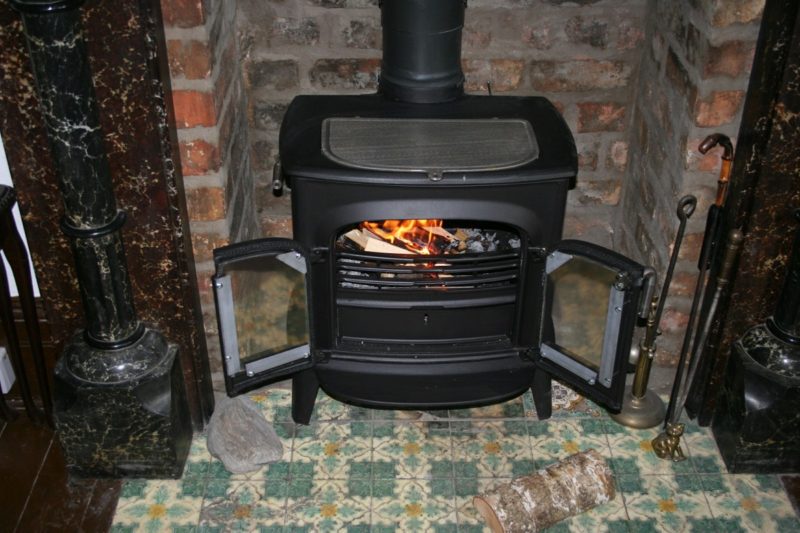What to put under wood stove? On a chilly day, nothing beats the comfort of a raging fire in a wood-burning stove, but you need to protect your house from the intense heat and ensuing flames. A wood-burning stove emits two types of heat: radiant and convective. Both contribute to the warmth and well-being provided by a fireplace. For example, if you sit near the stove, the radiant heat will make your face glow. In terms of heating, conductive heat happens when a stove distributes warmth where it is placed.
Overheating or even outright burning could occur if to any surface close to a fire for an extended period. That can happen when you use radiation to warm up a nearby surface, which then conducts the heat to whatever lies beneath the surface.
4 Materials To Put Under Wood Stove
What to put under wood stove? There are lots of things that you can place under your stove but a good understanding of structural engineering by engineers and contractors is needed to provide professional guidance on this topic. You can use the following materials to protect your house against intense heat.
#1. Concrete tiles
A tile made of the concrete backer board provides a heat-resistant and sturdy foundation. When it comes to quilts, the standard size is only 3 feet wide by 5 feet long. Use two sheets for the bottom layer and two more for the top layer to make a thicker pad.
You can shape and size the sheets to your specs by cutting them to your standards. First, sew the bottom and top layers with the seams running counter-clockwise. Finish with a heat-resistant fiberglass mesh seam tape after being bonded with a cement-based mortar.
Use a light coat of mortar and screws to attach the bottom sheets to the subfloor, then repeat the process with the upper sheets. Before installing the pad, you must remove the carpeting in the room.
#2. Fire-resistant mats
Build wood stove fireproof rugs out of cinderblocks. Lifting and distributing heat is made more accessible by using a heat-resistant material placed on top of the backer board, and the floor is protected at the same time. It is safer to use a thicker pad with air circulation under stoves that have no legs or with legs that are only 2 or 3 inches high, for example. Despite certain heat-resistant materials being taller, cinderblocks are the tallest.
You can use them to ventilate under the stove when installed on their side over a backer board. The cinderblocks should be set in the mortar that has been applied over the backer board’s pad. If cinderblock’s appeal isn’t what you’re looking for, consider a heat-resistant tile as an alternative. Leave a few empty spaces on either side of the tile to allow for airflow.
#3. High-temperature-resistant firebricks
Many wood-burning stoves and fireplaces utilize firebrick as a liner because it is heat-resistant. When put over the backer board, it gives the illusion of a historical fireplace while also protecting against heat and sparks. A firebrick is an option for any stove, no matter how small it is or with no legs. To provide for ventilation, remember to leave spaces between each row of bricks. Regardless, you might want to read “How a wood stove works?” before we proceed.
#4. Apply mortar
For stoves with longer legs, insert the bricks into the mortar on the pad. Firebrick serves a second purpose besides acting as a heat sink. The brick returns heat to the space where it stands. Firebricks with a slit in the middle can also be used. The bricks should be stacked cinderblock-style on their sides when using this method.
Whether it is made of stone or tile, it won’t make a difference. The distance from the stove’s base to the ground varies depending on the model. An appropriate low-profile stone or tile backer board wood stove pad is required for stoves that provide more heat.
Install stone or the best tile under a wood stove using the same techniques as you would for a floor or countertop, but do not use pre-mixed tile glue. The cement-based thin-set mortar will not catch fire or melt at high temperatures because of its high melting point.
Stones or tiles are positioned with backs against the backer board and pressed into a thin-set with a notched trowel. For a uniform look, use tile spacers or stones with irregular edges to fill in the spaces between the tiles. Use a grout bag to apply grout or pipe mortar to the tile joints. Instead of cinderblocks, use stones or tiles. And that is all the things you can put under a wood stove.
It’s A Wrap!
It’s not enough that you know what to put under wood stove. If possible, also keep a wood stove away from combustible materials such as concrete or brick. It’s still capable of transferring heat to whatever’s beneath it, which could result in ablaze. You can also install heat shields to protect the back of the wood stove. Here’s how to install heat shields behind a wood stove.
Conventional wisdom dictates that you should keep everything at least 36 inches away from the stove, including woodwork, unprotected walls, furniture, and even the stack of old newspapers you used to start the fiIn addition, an. An exposed stove pipe should have a minimum distance of 18 inches from an unprotected wall or ceiling.

